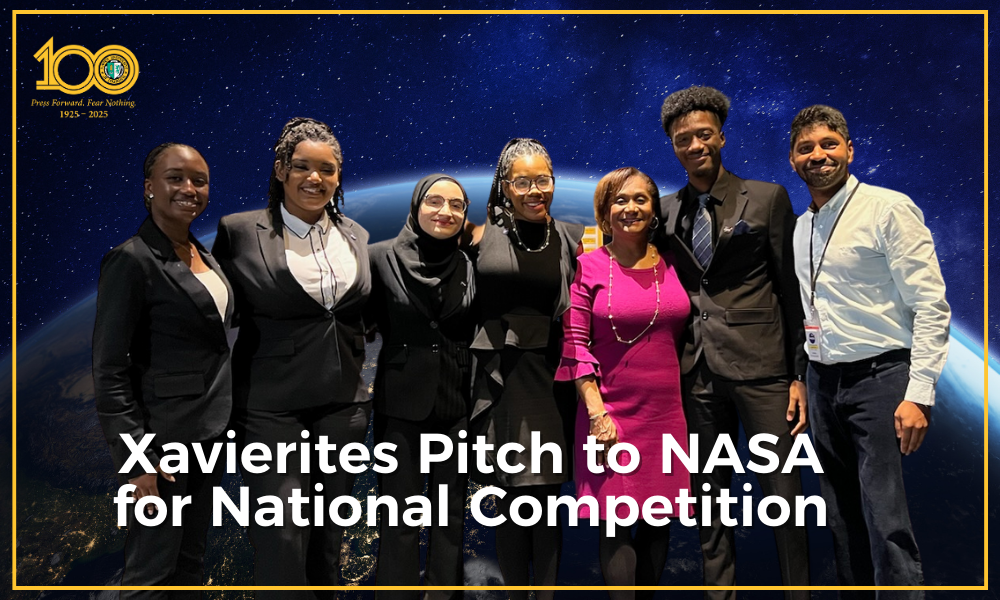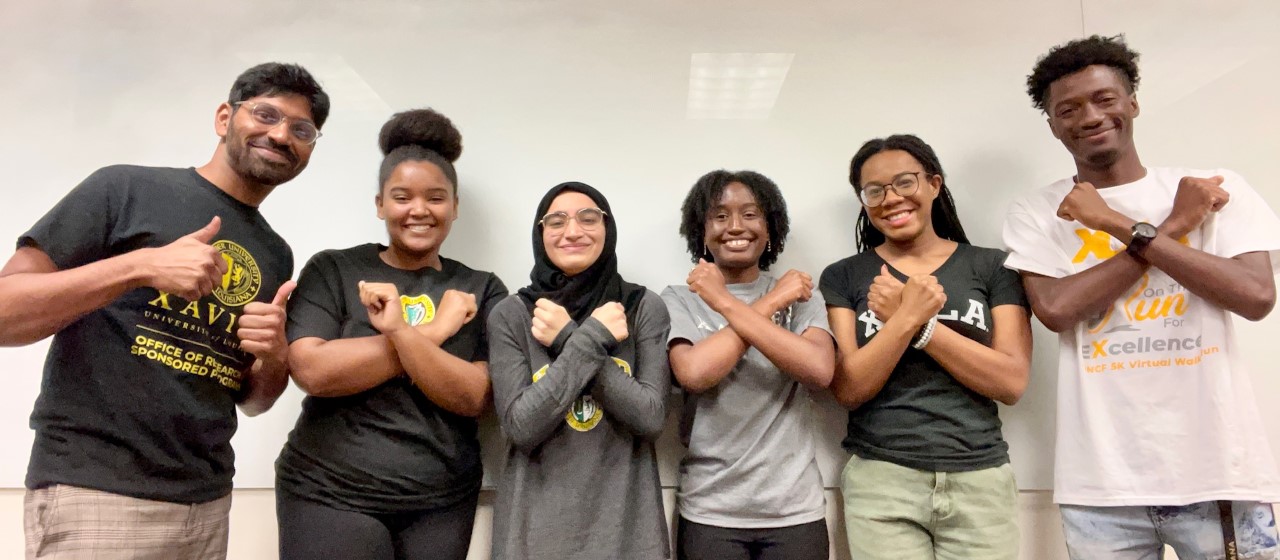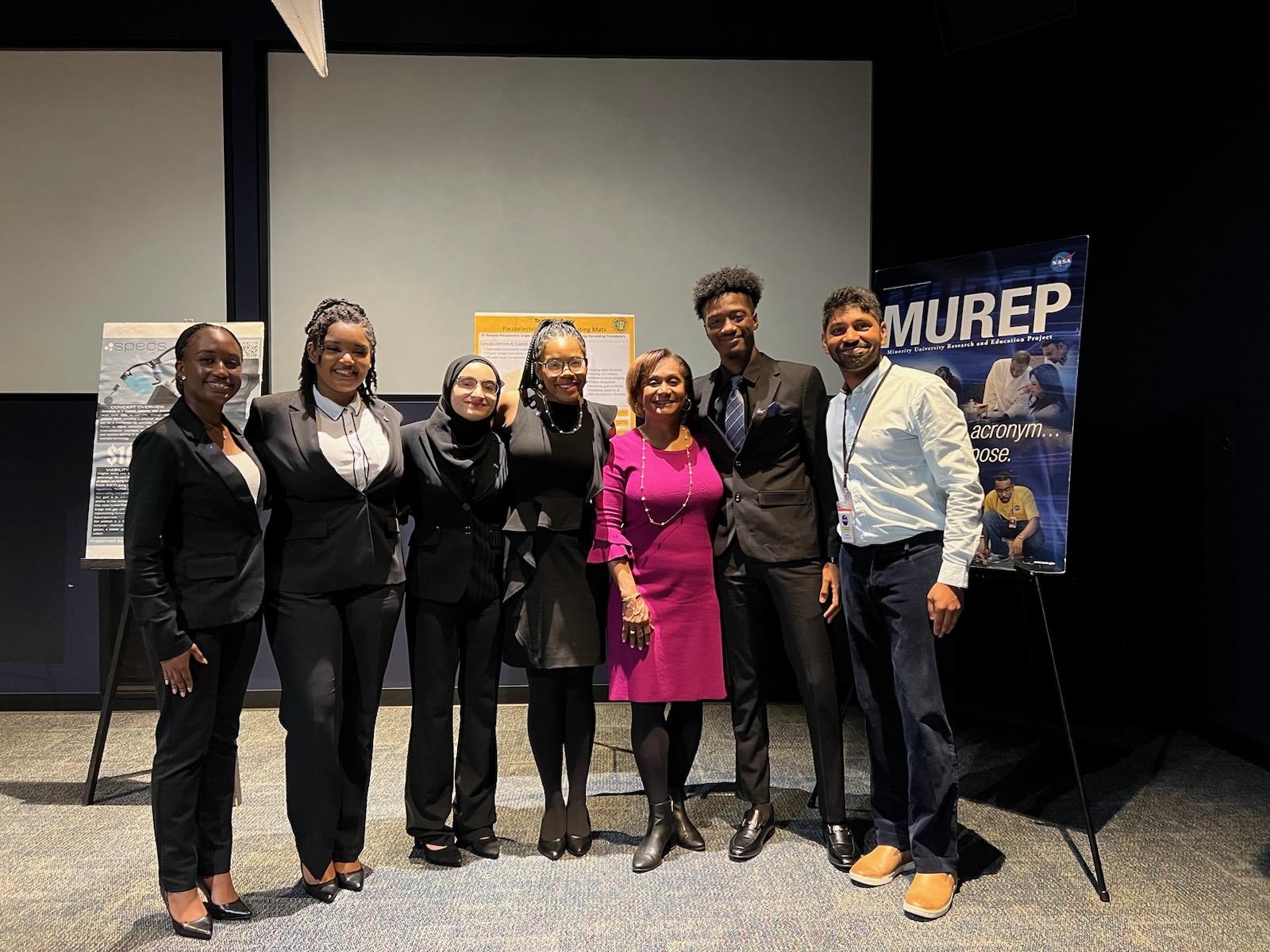Xavierites on Team Xenergy pitch tech transfer innovation to NASA as finalists in national competition

New Orleans, La – A hurricane has just passed through your neighborhood. The power is out, you do not have a generator, and your phone is dangerously low on battery. What if you could generate enough electricity to recharge your phone just by sitting down? That is the vision presented by the five Xavier students of Team Xenergy (Xavier Energy) to the National Aeronautics and Space Administration (NASA) Johnson Space Center in Houston on December 9.
The team pitched their commercial application and distribution plan for a piezoelectric, energy-harvesting mat (PEM) that could transfer self-generated sustainable energy wirelessly to various devices, mitigating the need for working wires and outlets. Team Xenergy was one of six finalist teams from across the nation in NASA’s higher education spinoff challenge, the Minority University Research and Education Project (MUREP) Innovation Tech Transfer Idea Competition (MITTIC).

Team Xenergy includes first-year Xavier students Jada Thibodeaux, Nyla Gayle and Amna Aslam and sophomores Bershell Reynaud and William Foster. They faced off against teams from the University of St. Thomas (Team Celts) and the University of Puerto Rico- Rio Piedras (Team Li2+Sen), as well as collaborative teams from East Los Angeles College, City College of San Francisco, College of Marin and California State University-Northridge (Team Frankenstein’s Gears), Hampton University and Tufts University (Team PowersIO), and from Hampton University and Boston College (Team Spectacle).
The teams were challenged to derive a commercial application of intellectual property (IP) of NASA. Though Xavier’s Team Xenergy did not ultimately take the prize, it still knocked it out of the park with its concept, with each group member taking turns to present different aspects of the commercial production and application of PEMs.
“The PEM will be a self-powered, autonomous system containing a 3-by-3-foot piezo relaxer sensor embedded in a 4-by-6-foot very sturdy [floor] mat, not very different from the standard leisure mats you might have in your home,” explained Foster during the presentation. He went on to describe how the PEM would be capable of integration with Wi-Fi networks and could store energy with an internal supercapacitor for later use.
Foster also shared that piezoelectric, or electric charges generated through mechanical stress or “pressure,” technology is not new; it has long been established for use in roadways, underneath railways, certain kinds of watches, pacemakers, and even light-up children’s shoes.
Ashwith Chilvery, Ph.D., assistant vice president for the Office of Research and Sponsored Programs (ORSP) and associate professor of physics at Xaiver, is a material scientist and has deep roots in research on piezoelectric materials. Dr. Chilvery is also the faculty leader of Xenergy and accompanied the team to Houston.
“Avenues such as NASA-MITTIC are much needed to drive today’s research to innovation that can make an economic and societal impact,” said Dr. Chilvery. “These brilliant students are driving the innovation that will affect future generations.”

The five Xavier students discovered in their research that current applications of piezoelectric materials are limited to 10 to the power of 4 picocoulombs, or units of electricity, per individual newton (10^4pC/N). In lay terms, current technology is limited in its ability to transfer mechanical energy and mechanical vibrations into electrical energy that can then be used. Team Xenergy thus proposed shattering that limitation through the application of NASA IP, increasing the constants by “100 times” that of anything on the market today with a much higher conversion efficiency.
Team Xenergy pitched harnessing the “wasted” energy that can be “scavenged” around the average person’s home using the PEM in everyday activities. They explained that among those gathered at the presentation, just moving and walking around all day could potentially generate 18-20 volts of electricity, enough energy to power the lights in a house or 12-15 AA batteries.
“PEMS can be used in gyms, on the dance floor, and in kitchens, but that’s not the overall concept!” said Reynaud about the everyday use of the technology. “The big picture is to ‘cut cords with the cords’ by using ambient wireless charging.”
Ambient wireless charging, a concept introduced nearly a decade ago, has been used in many of the newer-generation smartphones that can charge wirelessly- either with a charging pad or other power-sharing technology. Though an older concept, Team Xenergy’s new spin of incorporating pressure-produced energy vastly widens the impact.
True to the mission bestowed on students at Xavier to promote a more just and humane society across the globe, the team was emphatic about developing an alliance with a global partner for worldwide distribution, particularly in areas without consistent energy access. Aslam, who is from Pakistan, shared that the use in her home country, some areas of which are without reliable power, would be revolutionary.
“This product, I know for sure I can take it back home. Whenever I’m sitting in the dark, without electronics [access], I can [use the PEM to] charge my phone and connect to the outside world,” said Aslam. “This product really touched my heart because of this reason; because I can take it back home and help those in need.”
Watch Team Xenergy’s pitch here.
###
About Xavier University of Louisiana
Xavier University of Louisiana, America’s only historically Black and Catholic University, is ranked among the top three HBCUs (historically Black colleges and universities) in the nation. Recognized as a national leader in STEM and health sciences, Xavier produces more African American students who graduate from medical schools each year than any other university in the United States. Additionally, Xavier’s College of Pharmacy is also among the top producers of African American pharmacists in the country.
Established in 1925, by Saint Katharine Drexel and the Sisters of the Blessed Sacrament as a place for African Americans and Native Americans to receive a quality education, Xavier has since expanded its programs in art, business, education, biological sciences, chemistry, pharmacy and political science. More recent additions in robotics, bioinformatics, engineering, data science, neuroscience and genetics, in addition to new STEM-based master’s programs, have provided Xavier students (2815 undergraduates and 787 graduates) an unbeatable combination of traditional classroom study, hands-on research, service-learning opportunities and life experiences. Xavier students collaborate with world-renowned faculty, who are experts in their fields, to produce award-winning research and notable work. The winning Xavier formula is to provide students with a well-balanced curriculum and an environment that nurtures their intellect and feeds their souls, thereby facilitating a more just and humane society for all. For more information about Xavier University of Louisiana, visit us online at www.xula.edu or contact Regi Reyes at (504) 520-5240 or rreyes@xula.edu.